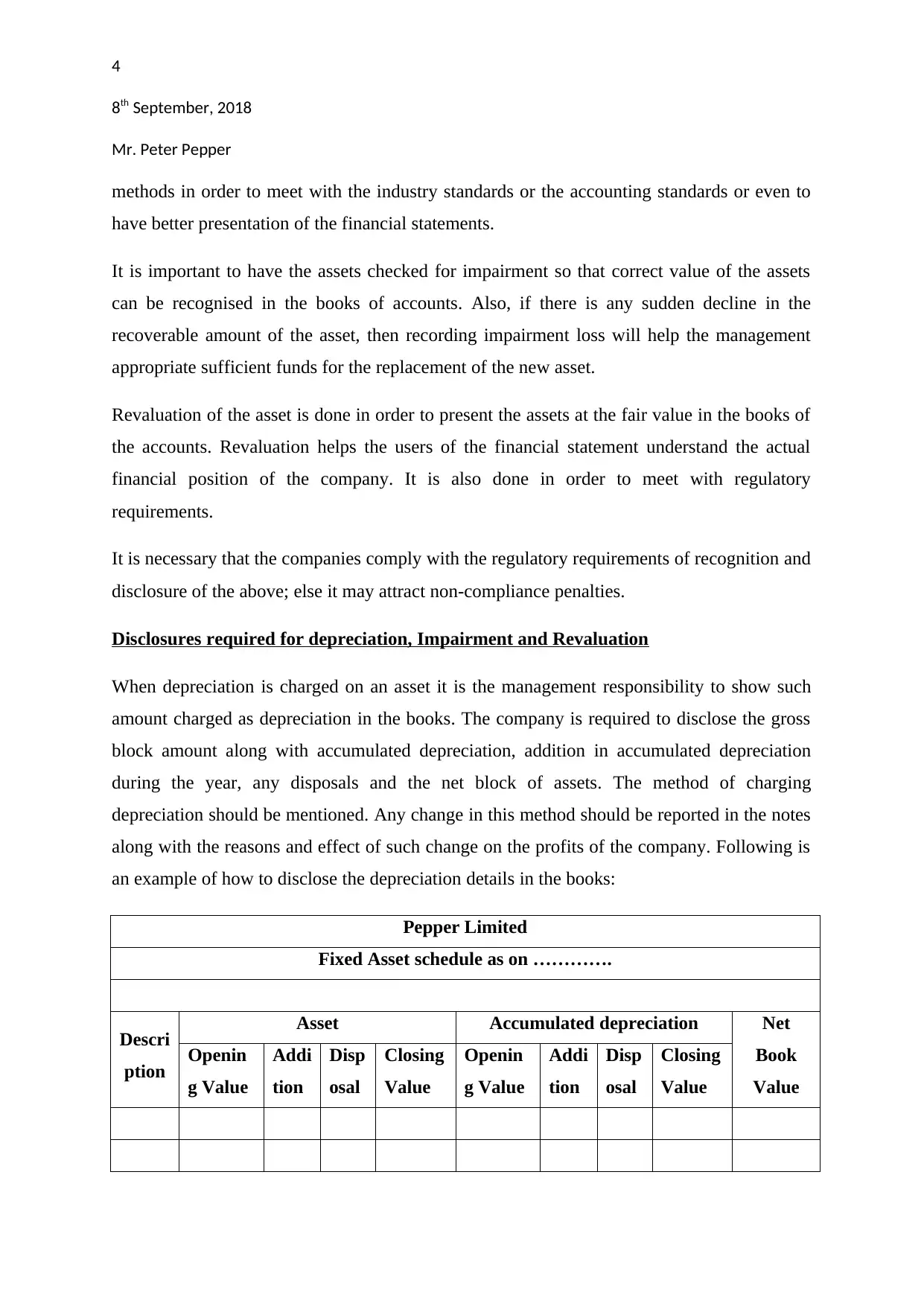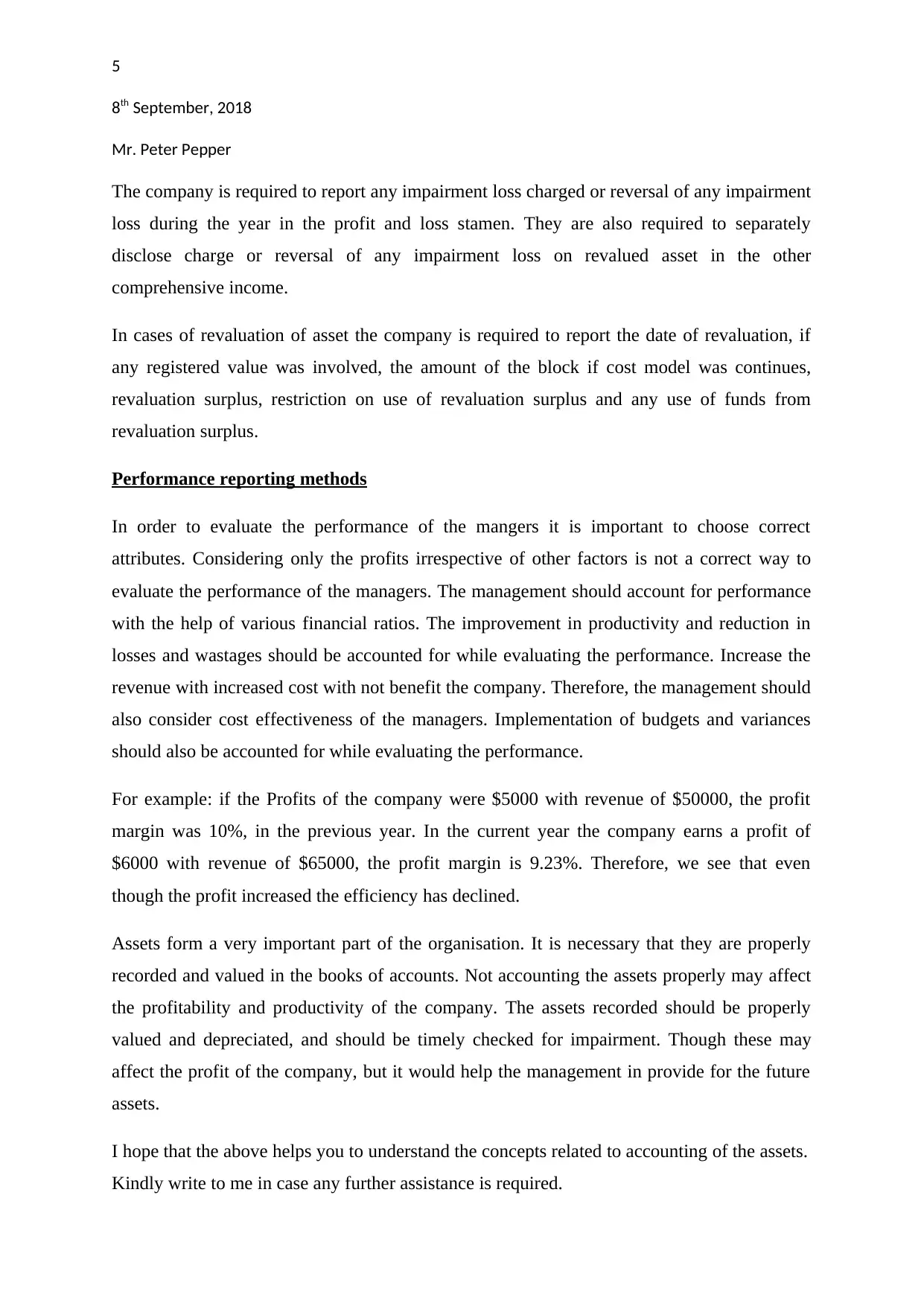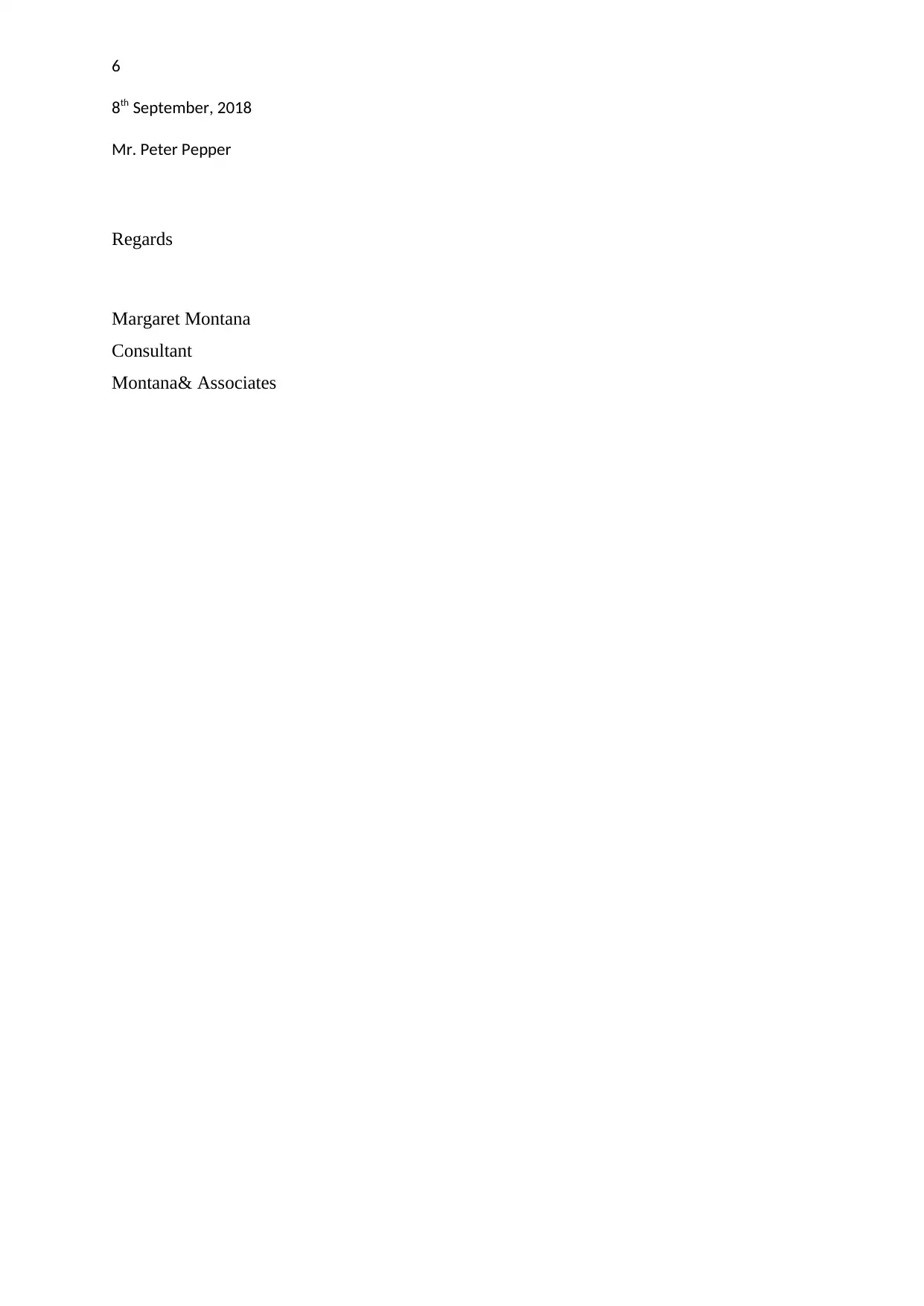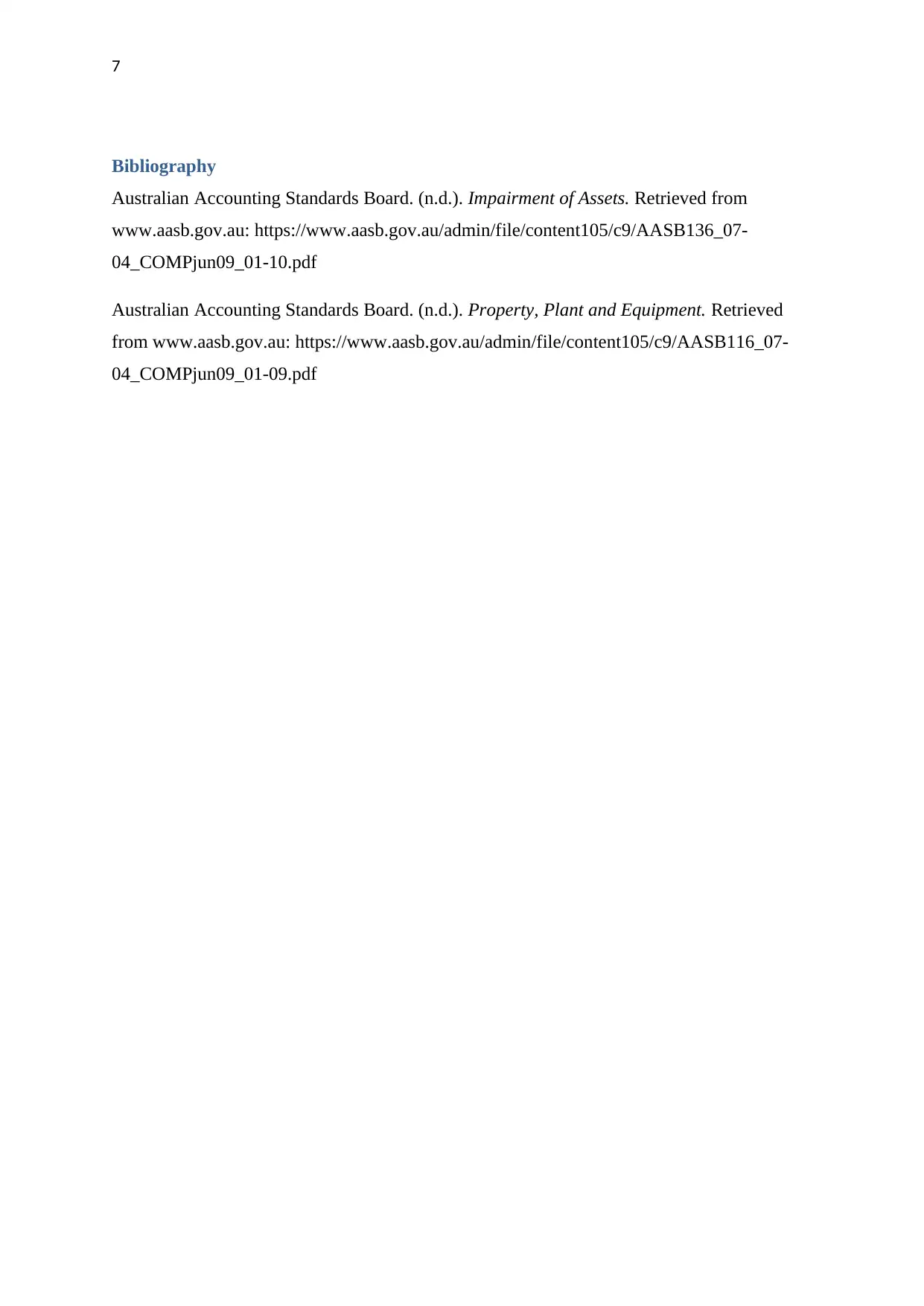ACCM4200 Financial Accounting and Reporting: Pepper Limited Analysis
VerifiedAdded on 2023/06/07
|7
|1551
|215
Report
AI Summary
This report addresses accounting issues for Pepper Limited concerning depreciation, impairment, and revaluation, as requested by Managing Director Peter Pepper. It differentiates between these concepts, explaining their impact on the company's profitability and the necessity for changes in their application. The report details disclosure requirements for each concept and discusses performance reporting methods, emphasizing the importance of accurate asset valuation and proper accounting practices. It also highlights how incorrect accounting can affect profitability and productivity, stressing the need for timely asset checks and appropriate depreciation methods. The document concludes with bibliography and emphasizes compliance with regulatory requirements.

1
Financial Accounting and Reporting
Financial Accounting and Reporting
Paraphrase This Document
Need a fresh take? Get an instant paraphrase of this document with our AI Paraphraser

2
8th September, 2018
Peter Pepper
Managing Director, Pepper Limited
Level 5, 49 William Street,
Brisbane QLD 4000
Dear Peter,
With respect to your email in connection with accounting issues for year end June, 2018,
please find below the explanation regarding various issues. In the following explanation we
have discussed various concepts of related assets such as depreciation, impairment and
revaluation.
Difference between Depreciation, Impairment and Revaluation
Deprecation is charge to the profit and loss towards the usage of an asset. When an asset is
used, its value is declined. Depreciation is the charge on the asst in order to account for its
usage, obsolesce and degradation in value due to efflux of time.
An asset is said to be impaired when the recoverable amount of the asset in an open market
falls below its carrying amount. Impairment is the decline in the value of the asset in the
market due to various factors. Once impairment is charges over an asset, it is not likely that
the recoverable amount of the asset will go up. For example, we have an asset with a carrying
amount of $40000, the recoverable amount of such asset is estimated to be $35000, the asset
is said to be impaired by $5000.
Revaluation of asset refers to change in fair value or value in use of the asset. The revaluation
is asset results in matching of the carrying amount of the asset with its fair value. Revaluation
may be done upwards or downwards, that is, the fair value may be increased or decreased.
(Australian Accounting Standards Board)
Impact of these on the profitability of the company
As discussed earlier depreciation is charge to the profit and loss. The amount of depreciation
charged is sent to the profit and loss statement, that is, depreciation reduces the profit of the
8th September, 2018
Peter Pepper
Managing Director, Pepper Limited
Level 5, 49 William Street,
Brisbane QLD 4000
Dear Peter,
With respect to your email in connection with accounting issues for year end June, 2018,
please find below the explanation regarding various issues. In the following explanation we
have discussed various concepts of related assets such as depreciation, impairment and
revaluation.
Difference between Depreciation, Impairment and Revaluation
Deprecation is charge to the profit and loss towards the usage of an asset. When an asset is
used, its value is declined. Depreciation is the charge on the asst in order to account for its
usage, obsolesce and degradation in value due to efflux of time.
An asset is said to be impaired when the recoverable amount of the asset in an open market
falls below its carrying amount. Impairment is the decline in the value of the asset in the
market due to various factors. Once impairment is charges over an asset, it is not likely that
the recoverable amount of the asset will go up. For example, we have an asset with a carrying
amount of $40000, the recoverable amount of such asset is estimated to be $35000, the asset
is said to be impaired by $5000.
Revaluation of asset refers to change in fair value or value in use of the asset. The revaluation
is asset results in matching of the carrying amount of the asset with its fair value. Revaluation
may be done upwards or downwards, that is, the fair value may be increased or decreased.
(Australian Accounting Standards Board)
Impact of these on the profitability of the company
As discussed earlier depreciation is charge to the profit and loss. The amount of depreciation
charged is sent to the profit and loss statement, that is, depreciation reduces the profit of the

3
8th September, 2018
Mr. Peter Pepper
current year. Though there is no actual cash flow, the profit of the company declines due to
depreciation.
Impairment loss any should be immediate recognised in the profit and loss stamen. The
difference between the carrying amount and recoverable amount of an asset, should be
transferred to the profit and loss statement as impairment loss towards asset, this will decline
the profits of the company. Such losses are to be shown as a separate line item in profit and
loss.
As discussed, revaluation may lead to increase or decrease in the carrying amount of the
asset. When the value of the asset increases, then a revaluation reserve of the same amount is
created this is shown as a part of the equity in balance sheet. Balance in such reserve is
transferred to surplus profits directly on sale on such assets. If the value of the asset declines
due to revaluation, then such losses is charges to profit and loss, except in cases when there
exists previously created revaluation reserve in connection with such assets. In such cases,
the revaluation loss is first written off with revalued loss and remaining amount is then
charged to the profit and loss statement. For example, say there is a machine which was
earlier revalued from $25000 to $35000, creating a revaluation surplus of $10000. Now the
same machine has been revalued downwards by $12000. In this case the revaluation loss will
first be written off form the surplus, and remaining amount $2000 will be charged to the
profit and loss statement.
All the above create a charge on the profit of the company. Depreciation, impairment and
revaluation losses are all written off in the profit and loss statement, decreasing the profit of
the year.
Need for changes required for depreciation, impairment and revaluation
There are various methods to charge depreciation. The method which is most suitable to the
industry type of the company should be opted for. (Australian Accounting Standards
Board)Depreciation is tool which is used by many managers in order to manipulate profits;
therefore it is important to implement the most suitable for of depreciation so that correct
profits of the company can be arrived at. It is impairment to bring changes in the depreciation
8th September, 2018
Mr. Peter Pepper
current year. Though there is no actual cash flow, the profit of the company declines due to
depreciation.
Impairment loss any should be immediate recognised in the profit and loss stamen. The
difference between the carrying amount and recoverable amount of an asset, should be
transferred to the profit and loss statement as impairment loss towards asset, this will decline
the profits of the company. Such losses are to be shown as a separate line item in profit and
loss.
As discussed, revaluation may lead to increase or decrease in the carrying amount of the
asset. When the value of the asset increases, then a revaluation reserve of the same amount is
created this is shown as a part of the equity in balance sheet. Balance in such reserve is
transferred to surplus profits directly on sale on such assets. If the value of the asset declines
due to revaluation, then such losses is charges to profit and loss, except in cases when there
exists previously created revaluation reserve in connection with such assets. In such cases,
the revaluation loss is first written off with revalued loss and remaining amount is then
charged to the profit and loss statement. For example, say there is a machine which was
earlier revalued from $25000 to $35000, creating a revaluation surplus of $10000. Now the
same machine has been revalued downwards by $12000. In this case the revaluation loss will
first be written off form the surplus, and remaining amount $2000 will be charged to the
profit and loss statement.
All the above create a charge on the profit of the company. Depreciation, impairment and
revaluation losses are all written off in the profit and loss statement, decreasing the profit of
the year.
Need for changes required for depreciation, impairment and revaluation
There are various methods to charge depreciation. The method which is most suitable to the
industry type of the company should be opted for. (Australian Accounting Standards
Board)Depreciation is tool which is used by many managers in order to manipulate profits;
therefore it is important to implement the most suitable for of depreciation so that correct
profits of the company can be arrived at. It is impairment to bring changes in the depreciation
⊘ This is a preview!⊘
Do you want full access?
Subscribe today to unlock all pages.

Trusted by 1+ million students worldwide

4
8th September, 2018
Mr. Peter Pepper
methods in order to meet with the industry standards or the accounting standards or even to
have better presentation of the financial statements.
It is important to have the assets checked for impairment so that correct value of the assets
can be recognised in the books of accounts. Also, if there is any sudden decline in the
recoverable amount of the asset, then recording impairment loss will help the management
appropriate sufficient funds for the replacement of the new asset.
Revaluation of the asset is done in order to present the assets at the fair value in the books of
the accounts. Revaluation helps the users of the financial statement understand the actual
financial position of the company. It is also done in order to meet with regulatory
requirements.
It is necessary that the companies comply with the regulatory requirements of recognition and
disclosure of the above; else it may attract non-compliance penalties.
Disclosures required for depreciation, Impairment and Revaluation
When depreciation is charged on an asset it is the management responsibility to show such
amount charged as depreciation in the books. The company is required to disclose the gross
block amount along with accumulated depreciation, addition in accumulated depreciation
during the year, any disposals and the net block of assets. The method of charging
depreciation should be mentioned. Any change in this method should be reported in the notes
along with the reasons and effect of such change on the profits of the company. Following is
an example of how to disclose the depreciation details in the books:
Pepper Limited
Fixed Asset schedule as on ………….
Descri
ption
Asset Accumulated depreciation Net
Book
Value
Openin
g Value
Addi
tion
Disp
osal
Closing
Value
Openin
g Value
Addi
tion
Disp
osal
Closing
Value
8th September, 2018
Mr. Peter Pepper
methods in order to meet with the industry standards or the accounting standards or even to
have better presentation of the financial statements.
It is important to have the assets checked for impairment so that correct value of the assets
can be recognised in the books of accounts. Also, if there is any sudden decline in the
recoverable amount of the asset, then recording impairment loss will help the management
appropriate sufficient funds for the replacement of the new asset.
Revaluation of the asset is done in order to present the assets at the fair value in the books of
the accounts. Revaluation helps the users of the financial statement understand the actual
financial position of the company. It is also done in order to meet with regulatory
requirements.
It is necessary that the companies comply with the regulatory requirements of recognition and
disclosure of the above; else it may attract non-compliance penalties.
Disclosures required for depreciation, Impairment and Revaluation
When depreciation is charged on an asset it is the management responsibility to show such
amount charged as depreciation in the books. The company is required to disclose the gross
block amount along with accumulated depreciation, addition in accumulated depreciation
during the year, any disposals and the net block of assets. The method of charging
depreciation should be mentioned. Any change in this method should be reported in the notes
along with the reasons and effect of such change on the profits of the company. Following is
an example of how to disclose the depreciation details in the books:
Pepper Limited
Fixed Asset schedule as on ………….
Descri
ption
Asset Accumulated depreciation Net
Book
Value
Openin
g Value
Addi
tion
Disp
osal
Closing
Value
Openin
g Value
Addi
tion
Disp
osal
Closing
Value
Paraphrase This Document
Need a fresh take? Get an instant paraphrase of this document with our AI Paraphraser

5
8th September, 2018
Mr. Peter Pepper
The company is required to report any impairment loss charged or reversal of any impairment
loss during the year in the profit and loss stamen. They are also required to separately
disclose charge or reversal of any impairment loss on revalued asset in the other
comprehensive income.
In cases of revaluation of asset the company is required to report the date of revaluation, if
any registered value was involved, the amount of the block if cost model was continues,
revaluation surplus, restriction on use of revaluation surplus and any use of funds from
revaluation surplus.
Performance reporting methods
In order to evaluate the performance of the mangers it is important to choose correct
attributes. Considering only the profits irrespective of other factors is not a correct way to
evaluate the performance of the managers. The management should account for performance
with the help of various financial ratios. The improvement in productivity and reduction in
losses and wastages should be accounted for while evaluating the performance. Increase the
revenue with increased cost with not benefit the company. Therefore, the management should
also consider cost effectiveness of the managers. Implementation of budgets and variances
should also be accounted for while evaluating the performance.
For example: if the Profits of the company were $5000 with revenue of $50000, the profit
margin was 10%, in the previous year. In the current year the company earns a profit of
$6000 with revenue of $65000, the profit margin is 9.23%. Therefore, we see that even
though the profit increased the efficiency has declined.
Assets form a very important part of the organisation. It is necessary that they are properly
recorded and valued in the books of accounts. Not accounting the assets properly may affect
the profitability and productivity of the company. The assets recorded should be properly
valued and depreciated, and should be timely checked for impairment. Though these may
affect the profit of the company, but it would help the management in provide for the future
assets.
I hope that the above helps you to understand the concepts related to accounting of the assets.
Kindly write to me in case any further assistance is required.
8th September, 2018
Mr. Peter Pepper
The company is required to report any impairment loss charged or reversal of any impairment
loss during the year in the profit and loss stamen. They are also required to separately
disclose charge or reversal of any impairment loss on revalued asset in the other
comprehensive income.
In cases of revaluation of asset the company is required to report the date of revaluation, if
any registered value was involved, the amount of the block if cost model was continues,
revaluation surplus, restriction on use of revaluation surplus and any use of funds from
revaluation surplus.
Performance reporting methods
In order to evaluate the performance of the mangers it is important to choose correct
attributes. Considering only the profits irrespective of other factors is not a correct way to
evaluate the performance of the managers. The management should account for performance
with the help of various financial ratios. The improvement in productivity and reduction in
losses and wastages should be accounted for while evaluating the performance. Increase the
revenue with increased cost with not benefit the company. Therefore, the management should
also consider cost effectiveness of the managers. Implementation of budgets and variances
should also be accounted for while evaluating the performance.
For example: if the Profits of the company were $5000 with revenue of $50000, the profit
margin was 10%, in the previous year. In the current year the company earns a profit of
$6000 with revenue of $65000, the profit margin is 9.23%. Therefore, we see that even
though the profit increased the efficiency has declined.
Assets form a very important part of the organisation. It is necessary that they are properly
recorded and valued in the books of accounts. Not accounting the assets properly may affect
the profitability and productivity of the company. The assets recorded should be properly
valued and depreciated, and should be timely checked for impairment. Though these may
affect the profit of the company, but it would help the management in provide for the future
assets.
I hope that the above helps you to understand the concepts related to accounting of the assets.
Kindly write to me in case any further assistance is required.

6
8th September, 2018
Mr. Peter Pepper
Regards
Margaret Montana
Consultant
Montana& Associates
8th September, 2018
Mr. Peter Pepper
Regards
Margaret Montana
Consultant
Montana& Associates
⊘ This is a preview!⊘
Do you want full access?
Subscribe today to unlock all pages.

Trusted by 1+ million students worldwide

7
Bibliography
Australian Accounting Standards Board. (n.d.). Impairment of Assets. Retrieved from
www.aasb.gov.au: https://www.aasb.gov.au/admin/file/content105/c9/AASB136_07-
04_COMPjun09_01-10.pdf
Australian Accounting Standards Board. (n.d.). Property, Plant and Equipment. Retrieved
from www.aasb.gov.au: https://www.aasb.gov.au/admin/file/content105/c9/AASB116_07-
04_COMPjun09_01-09.pdf
Bibliography
Australian Accounting Standards Board. (n.d.). Impairment of Assets. Retrieved from
www.aasb.gov.au: https://www.aasb.gov.au/admin/file/content105/c9/AASB136_07-
04_COMPjun09_01-10.pdf
Australian Accounting Standards Board. (n.d.). Property, Plant and Equipment. Retrieved
from www.aasb.gov.au: https://www.aasb.gov.au/admin/file/content105/c9/AASB116_07-
04_COMPjun09_01-09.pdf
1 out of 7
Related Documents
Your All-in-One AI-Powered Toolkit for Academic Success.
+13062052269
info@desklib.com
Available 24*7 on WhatsApp / Email
![[object Object]](/_next/static/media/star-bottom.7253800d.svg)
Unlock your academic potential
Copyright © 2020–2025 A2Z Services. All Rights Reserved. Developed and managed by ZUCOL.





